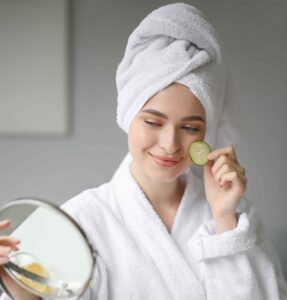
You know that golden-hour glow you chase in photos? Your skin is chasing it too—except without protection, UV rays can turn that glow into premature aging, pigmentation and even health risks. For Indian skin tones—prone to melasma, hyperpigmentation and sensitivity to heat—sunscreen isn’t optional. It’s your daily non-negotiable armor.
In this guide, you’ll learn why sunscreen matters, how to pick the right formula, and exactly how to make it work in your Indian climate and lifestyle.
1. Why Sunscreen Is Your Skincare MVP
- UV Damage Is Cumulative
Every minute unprotected adds up. UVA penetrates deep to break down collagen; UVB triggers redness and burns. Over years, that leads to fine lines, dark spots and uneven tone. - Indian Skin Needs Extra Care
Melanin gives some natural protection, but it also makes Indian skin more susceptible to post-inflammatory hyperpigmentation. Once a dark spot appears, it can linger—making prevention critical. - Daily Protection—Indoors and Out
Windows, screens and clouds don’t block UV. Indoor lighting and reflected rays still reach you. A morning application is your first line of defense, even on “office days.”
2. Types of Sunscreen: Physical vs. Chemical
| Feature | Physical (Mineral) Sunscreen | Chemical Sunscreen |
|---|---|---|
| Active ingredients | Zinc oxide, titanium dioxide | Avobenzone, octocrylene, oxybenzone |
| UV coverage | Broad-spectrum by default | Requires blend for broad-spectrum |
| Skin feel | Slight white cast; heavier feel | Lightweight; invisible finish |
| Best for | Sensitive, acne-prone skin | Normal to oily, daily wear |
| Reapplication needed | After sweating/swimming | After sweating/swimming |
3. Key Considerations for Indian Skin
- White Cast & Tinted Options
- Traditional mineral sunscreens can leave a pale cast on deeper tones. Look for “sheer” or “tinted” mineral formulas—tint matches your tone and eliminates ashy appearance.
- Texture & Finish
- Humidity in metros can turn sunscreen into an unwelcome sheen. Gel-creams and fluid lotions absorb faster, control oil, and layer seamlessly under makeup.
- SPF and PA Ratings
- Choose at least SPF 30 with PA +++ (or higher) to block both UVB and UVA. PA rating is crucial for long-term aging protection.
- Water- and Sweat-Resistance
- For monsoon workouts or summer commutes, “water-resistant” labels ensure protection stays effective through sweat or light rain.
4. How to Apply Sunscreen for Maximum Efficacy
- Amount Matters
- Use at least 1 ₹ coin–sized dollop for your face, and a palm-ful for neck, décolletage and hands.
- Layering Order
- Cleanser → Toner → Serum → Moisturizer → Sunscreen → Makeup (if any)
- Timing
- Apply 15–20 minutes before sun exposure. Reapply every 2–3 hours if you’re outdoors, or immediately after swimming/sweating.
- Don’t Skip “Hidden” Areas
- Ears, lips, hairline, and backs of hands need coverage too. Use a lip-sunscreen or SPF balm for lips.
5. Product Recommendations Under ₹1,000
| Category | Product | Key Features | Approx. Price |
|---|---|---|---|
| Mineral (Tinted) | Brand A Sheer Tint Mineral SPF 50 PA+++ | Tinted, non-ashy, broad-spectrum | ₹850 |
| Chemical (Gel-Cream) | Brand B Oil-Control Sunscreen SPF 30 | Lightweight, non-greasy, sweat-resistant | ₹499 |
| Combo (Physical + Chem) | Brand C Hybrid Sunscreen SPF 50 | Broad spectrum, matte finish, water-resistant | ₹950 |
6. Busting Common Myths
- “My dark skin doesn’t need sunscreen.”
Darker tones still suffer DNA damage and collagen breakdown—sun protection is non-negotiable. - “Sunscreen causes breakouts.”
Choose non-comedogenic, gel-based or mineral formulas. Patch-test first. - “One application is enough.”
Protection degrades—reapply every two hours, especially if you’re outdoors.
7. Integrating Sunscreen into Your Daily Life
- Keep a travel-size tube in your bag for midday touch-ups.
- Use makeup with built-in SPF as a secondary layer, never as a primary source.
- Pair sunscreen with antioxidants (Vitamin C serum) in the morning to neutralize free radicals.


